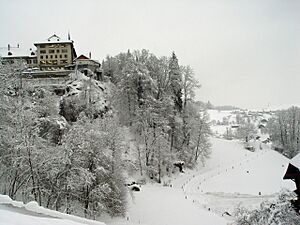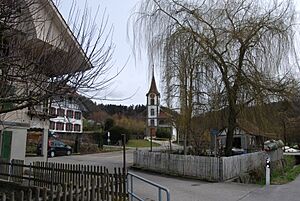Krauchthal facts for kids
Quick facts for kids
Krauchthal
|
||
|---|---|---|

Half-timbered houses in the center of Krauchthal village
|
||
|
||
| Country | Switzerland | |
| Canton | Bern | |
| District | Emmental | |
| Area | ||
| • Total | 19.43 km2 (7.50 sq mi) | |
| Elevation | 585 m (1,919 ft) | |
| Population
(Dec 2020 )
|
||
| • Total | 2,384 | |
| • Density | 122.70/km2 (317.78/sq mi) | |
| Postal code |
3326
|
|
| Surrounded by | Bäriswil, Bolligen, Burgdorf, Hindelbank, Lützelflüh, Mattstetten, Mötschwil, Oberburg, Vechigen | |
| Twin towns | Kamenný Újezd (Czech Republic) | |
Krauchthal is a small town, also called a municipality, in Switzerland. It's located in the Emmental district within the canton of Bern.
Contents
History of Krauchthal
Krauchthal was first mentioned in old writings between 1108 and 1122. The nearby village of Hettiswil was mentioned even earlier, in 1107.
Ancient Settlements and Castles
The very first signs of people living here are neolithic tools found in places like Mooshubel. These tools are from the Stone Age, showing that people lived here thousands of years ago.
Later, during the Roman era, wooden posts from a settlement were found on Thornberg. There were also remains of a Roman house nearby.
In the Middle Ages, there were three castles in the area: Thorberg Castle, Liebenfels-Sodfluh Castle, and Tannstigli. These castles were built close enough to see each other. From 1175 to 1397, Thorberg Castle was home to the Lords of Thorberg. After the last Lord, Peter von Thorberg, died in 1397, he gave his lands to a group of monks called the Carthusians. They turned the castle into a monastery. The Carthusian monks became the biggest landowners in Krauchthal.
The village church of St. Mauritius in Krauchthal was first mentioned in 1270.
Hettiswil Priory and Bernese Control
In the village of Hettiswil, a Cluniac Priory (a type of small monastery) was built during the High Middle Ages. Today, only the foundations of its old Romanesque church can be seen. This Priory also looked after a chapel on Sandhubel, mentioned in 1560, but that building is now gone.
In 1107, the village of Hettiswil and the right to run its local court were given to the Priory. However, by 1406, both the local and higher courts in Hettiswil came under the control of Bern, a powerful city. Even so, the Priory remained a large landowner.
Since the 1500s, people have lived in special cliff dwellings in the Linden valley.
The Reformation and Thorberg Prison
Both Krauchthal and Hettiswil were under the control of the monasteries until Bern accepted the Protestant Reformation. In 1528, Bern took over most religious buildings and their properties. A Bernese official, called a vogt, was then put in charge of the area from Thorberg Castle. Hettiswil became part of Krauchthal's church area.
Thorberg Castle remained the home of the Bernese vogt until 1798. It also served as a place for people in need, like an almshouse (a place for the poor). In 1805, the almshouse became a reformatory (a place to help people improve their lives) and a school. Later, in 1849, it became a workhouse. In 1893, a new cell block was built, and it became a prison. More parts were added to the prison over the years.
Farming and Economy Changes
In 1470, the villages of Hettiswil, Krauchthal, and Hub worked together on farming and timber rights. By 1550, they had cleared a forest and divided the land among farmers. After the monasteries were taken over by Bern, their land was sold to local farmers.
By the early 1800s, many farmers started raising dairy cows and growing hay instead of grain. A dairy and cheese factory opened in Hettiswil in 1848. Between 1855 and 1863, the community drained wet areas in the valley, creating more farmland. Besides farming, the prison at Thorberg and a sandstone quarry also provided jobs for the people of Krauchthal.
Geography of Krauchthal
Krauchthal covers an area of about 19.44 square kilometers. A large part of this land, about 42.5%, is used for farming. Nearly half of the area, 49.6%, is covered by forests. About 7% of the land is used for buildings and roads.
Krauchthal includes the main village of Krauchthal, as well as Hettiswil, Hub im Tal, Dieterswald, and Thorberg.
Coat of Arms
The blazon of Krauchthal's coat of arms shows a red stripe going across a silver background. On either side of the stripe are two red roses with green leaves.
Population and People
Krauchthal has a population of about 2,400 people. A small percentage, around 3.8%, are people from other countries.
Most people in Krauchthal speak German as their first language (about 91.3%). Albanian is the second most common language, and French is the third.
The population is almost evenly split between males and females. Many people living in Krauchthal were born there or in the same canton of Bern.
Economy and Jobs
Krauchthal has a low unemployment rate, which means most people who want to work can find jobs. In 2008, there were 569 people working in the municipality.
Jobs in Krauchthal are divided into three main areas:
- Primary sector: This includes farming and forestry. About 169 people work in this area.
- Secondary sector: This includes manufacturing (making things) and construction (building things). About 166 people work here.
- Tertiary sector: This includes services like sales, transportation, hotels, restaurants, education, and healthcare. About 234 people work in this sector.
Many people who live in Krauchthal travel to other towns for work. Most people use a private car to get to work, while a smaller number use public transportation.
Religion
Based on a 2000 survey, most people in Krauchthal belong to the Swiss Reformed Church (about 73.6%). A smaller number are Roman Catholic (8.5%). There are also people who belong to other Christian churches, Islamic, Buddhist, and Hindu faiths. Some people do not belong to any church.
Education
In Krauchthal, many people have completed their high school education. About 11.4% have gone on to higher education at a university or a specialized college.
The school system in Bern canton starts with one year of optional Kindergarten. Then, students go to six years of Primary school. After that, there are three years of lower Secondary school, where students are grouped by their abilities. After secondary school, students can continue their education or start an apprenticeship (learning a trade on the job).
In the 2010-2011 school year, 181 students attended schools in Krauchthal. There were 40 kindergarten students and 141 primary school students.
See also
 In Spanish: Krauchthal para niños
In Spanish: Krauchthal para niños
Images for kids










